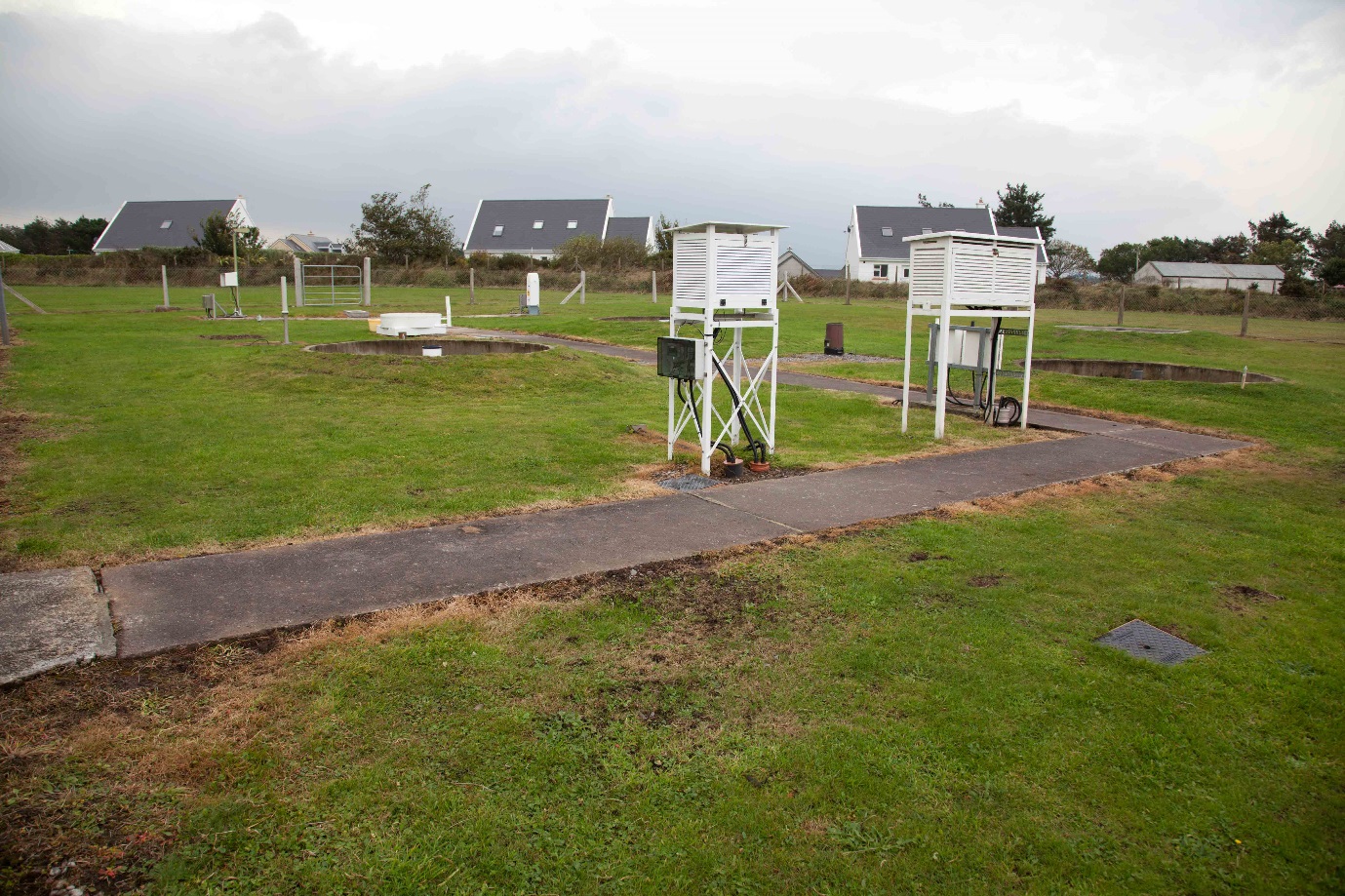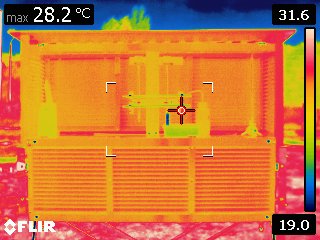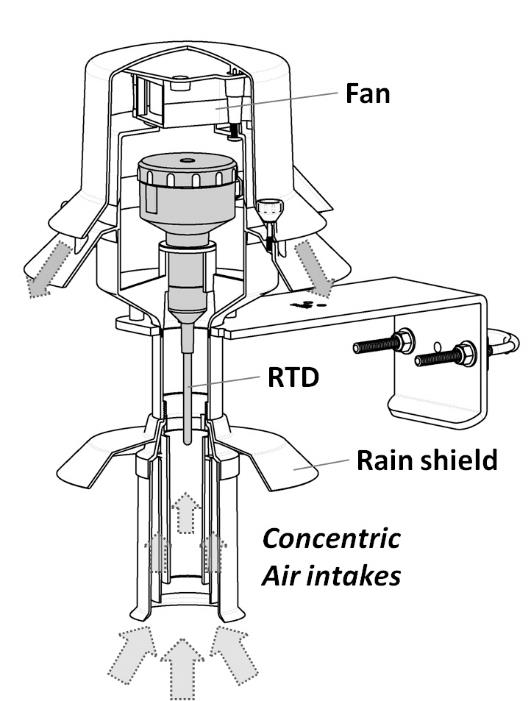By Stephen Burt
‘Temperature’ is a measure of heat energy, itself a proxy for the kinetic energy of the molecules within a substance. ‘Air temperature’ is the most widely measured environmental variable, and it influences what we wear, what we do, and how we do it: the properties of materials: untold biological, physical and chemical processes: industrial operations, aviation, energy demand, and many others. It has, of course, also become the dominant benchmark for climate change measurements and forecasts, including last week’s news about 2014 likely to be the warmest year on the long Central England Temperature series record (commenced 1659).
The first instrumental measurements of air temperature were made almost 400 years ago, shortly after the invention of the sealed liquid-in-glass thermometer by Ferdinand II, Grand Duke of Tuscany, around 1641 (Middleton 1966, 1969 and Strangeways 2010). The intervening centuries have seen many developments and improvements in both thermometry and attempts to measure ‘air temperature’, so one could perhaps be forgiven for assuming that methods for the accurate and precise determination of air temperature were done and dusted long ago. In fact, accuracy remains elusive even today, and this week Giles Harrison and I are presenting at the Metrology for Meteorology conference at the UK’s National Physical Laboratory on this important and topical question.
Whilst an apparently simple concept, accurate and precise measurements of the temperature of the air involves minimising errors in a great many variables. In many ways, the sensor itself (whether a conventional liquid-in-glass thermometer, or more usually these days some form of electrical sensor connected to a datalogger) is the least of the problems – although accuracy, precision, response time, robustness, stability, recording method, calibration and scale(s) all have to be carefully considered. The medium itself – air – is a poor conductor of heat, and in order to achieve an acceptable response time some form of ventilation over the sensor is required. This is most often achieved by passive (natural) ventilation methods (i.e., relying on the breeze), but when the wind falls light, measurements can quickly become unrepresentative, particularly in strong sunshine. The largest source of potential errors in air temperature measurements come from the immediate environment – approaches are needed to minimise heating from shortwave (solar) radiation, heating and cooling from longwave (terrestrial) radiation, cooling from precipitation deposition, all the while maintaining natural ventilation as far as possible. The height of the sensor above ground and the nature of the ground surface are also important factors.
Over the years, a great many shielded thermometer enclosures have been proposed. A double-louvred approach was first suggested by Thomas Stevenson, the famous civil engineer from the family that built most of Scotland’s lighthouses, in the Journal of the Scottish Meteorological Society (Stevenson 1866). Although many different patterns and sizes have evolved over time and slightly different standards exist across the world, the Stevenson-type screen (known as a ‘Cotton Region Shelter’ in the United States) is the nearest we have to a worldwide standard. Originally, Stevenson screens were made of wood: nowadays, an increasing number are made of plastic materials, which require much less maintenance as their surface properties are less likely to degrade over time (although a recent paper – Lopardo et al, 2014 – has drawn attention to temperature differences in automatic weather station (AWS) screens resulting from colour differences due to ageing in the plastic used by one manufacturer). Figure 1 illustrates the standard type of Stevenson screen in use within the UK and Ireland today: there is one in the Observatory enclosure, together with two larger models to a similar pattern (Figure 2).
Figure 1. A modern ‘Metspec’ plastic-and-aluminium Stevenson screen (left) alongside a large Stevenson screen made of wood (right). Valentia Observatory, Ireland. Photograph © Stephen Burt
Figure 2. An infrared image of one of the large (plastic-and-aluminium) Stevenson screens in the Atmospheric Observatory at the University of Reading, showing the variation in emitted temperature within the enclosure. Photograph by Stephen Burt.
The Stevenson screen has been the accepted ‘standard’ within the United Kingdom since 1884. The original use for ‘meteorological’ measurements (including extension during the 20th century for synoptic and aviation purposes) has now been extended to ‘climate’ measurements, for which more is expected. The design has known faults – namely, significant lag in light winds and appreciable warming in strong sunshine (sometimes 2-3 K), particularly in light winds (Harrison 2011) – and numerous alternatives have been proposed to replace it. Today, we are in a state of flux, with a mix of ‘Victorian’ standards such as the Stevenson screen co-existing alongside modern AWSs, the latter using multiple variations of sensor and radiation screen design, often proprietary. Such a mix of methods not only means that in many cases we have a measure which is more accurately ‘screen temperature’ rather than ‘air temperature’, but which clearly engenders a lack of spatial and temporal homogeneity. Long-term stability, accuracy and precision are hard to achieve when measurement methods change over time: climate change benchmark measurements require surface air temperature accuracy and precision to within 0.05 K/decade, a very demanding requirement indeed.
The most likely candidate for a future standard of measuring air temperature is an aspirated thermometer method, first advocated by John Aitken and Richard Assman in the 1880s (Strangeways 2010). In an aspirated measurement, air is drawn in from the environment over a sensor – at typically 5-10 m s-1 (Figure 3), although the exact rate is not critical. Such a method almost eliminates errors arising from both shortwave and longwave radiative heating and conduction errors, but the method requires a reliable power supply of at least a few Watts, not always possible at more remote observation sites. Any new method will, of course, require a careful series of overlapping measurements with ‘conventional’ records to avoid destroying the homogeneity of existing temperature series.
Figure 3. Sectional view of RM Young Model 43502 Aspirated Radiation Shield (33 cm high x 20 cm diameter). Air is drawn through the unit using the top-mounted fan; the temperature sensor (RTD) is protected from solar radiation and precipitation by coaxial PVC tubes, thermally insulated from each other, shielding the sensor from external thermal radiation and minimising any heating effects within the body of the unit. Depending upon the sensor size, the airflow past the sensor is between 5 and 11 metres per second. (Figure 5.10 in The Weather Observer’s Handbook, courtesy of Cambridge University Press and RM Young Company, Traverse City, Michigan USA)
Looking to the future, the methodology established in the United States is worth examining. More than a decade ago, NOAA set out to establish a sustainable high-quality climate observation network with the goal of answering in 2050, with the highest degree of confidence, the question: How has the climate of the nation changed over the past 50 years? Thus was born the US Climate Reference Network, USCRN. Three independent automated measurements of temperature and precipitation are made at each site, alongside wind speed and solar radiation. The chosen sites are in ‘pristine environments’ (examples in Figure 4, Figure 5), expected to be free of development for many decades, and the emphasis is on continuity of record, regular calibration (annually) and highly accurate observations. To date, 114 such sites have been established in the continental United States for the express purpose of detecting the national signal of climate change (Diamond 2013).
Figure 4. A US Climate Reference Network site in Colorado (40.8°N, 104.8°W, 1653 m AMSL) – source http://www.ncdc.noaa.gov/crn/#. Courtesy NOAA.
Figure 5. The US Climate Reference Network site at Mauna Loa Observatory, Hawaii (19.5°N, 155.6°W, 3381 m AMSL) – source http://www.ncdc.noaa.gov/crn/#. Courtesy NOAA.
Is this a methodology that UK and European authorities should consider adopting? Establishing small pilot networks and overlap schemes now would minimise the damage to existing long-term records, should the World Meteorological Organization eventually mandate aspirated temperatures as the new global standard. Perhaps, after 400 years, we can finally say that we have a method for measuring air temperatures that is both precise and accurate. I suspect its widespread adoption amongst standards bodies and national meteorological services may be quite another matter altogether.
FORTHCOMING MEETING
There is a forthcoming Royal Meteorological Society meeting on ‘Future measurements for climate monitoring’ (details and registration form) which will cover this and other relevant topics. It will be held at Imperial College, London, on Wednesday 18 March 2015.
REFERENCES
Diamond, H. J., Karl, T.R, Palecki, M.A. et al, 2013. U.S. climate reference network after one decade of operations: status and assessment. Bull. Amer. Meteorol. Soc., 94 (4), pp 485-498
Harrison, R. G., 2011. Lag-time effects on a naturally ventilated large thermometer screen. Q. J. R.Meteorol. Soc., 137, Issue 655, January 2011 Part B, pp 402–408
Lopardo, G., Bertiglia, F., Curci, S., Roggero, G. and Merlone, A., 2014. Comparative analysis of the influence of solar radiation screen ageing on temperature measurements by means of weather stations. Int. J. Climatol., 34, pp 1297–1310. doi: 10.1002/joc.3765
Middleton, W.E.K., 1966. A history of the thermometer and its uses in meteorology. Johns Hopkins, Baltimore
Middleton, W.E.K., 1969. Invention of the meteorological instruments. Johns Hopkins, Baltimore
Stevenson, Thomas, 1866. New description of box for holding thermometers. Journal of the Scottish Meteorological Society, 1, p. 122
Strangeways, Ian, 2009. Measuring global temperatures. Cambridge University Press
Stephen Burt is the author of The Weather Observer’s Handbook, published by Cambridge University Press

Giles Harrison is the author of Meteorological Measurements and Instrumentation, published by Wiley






